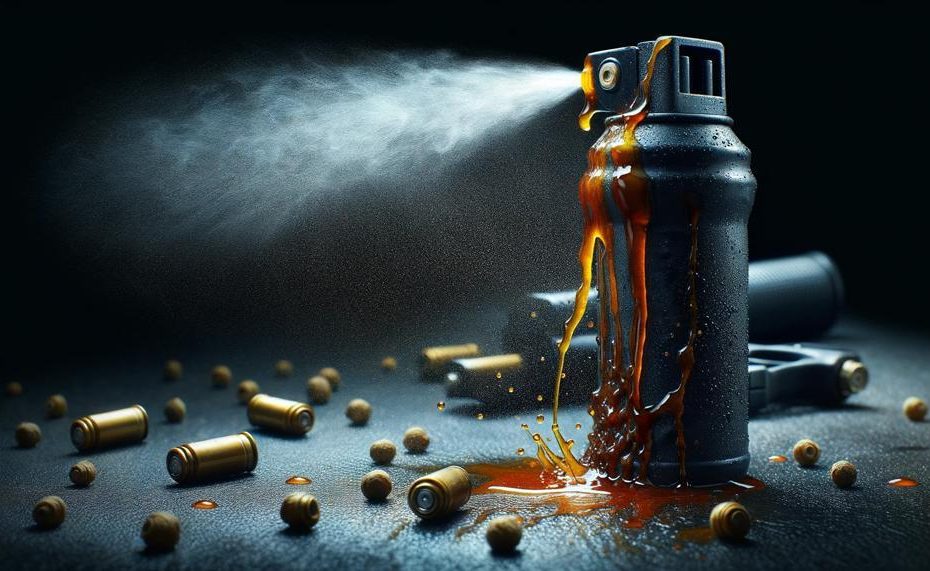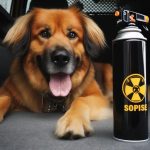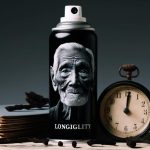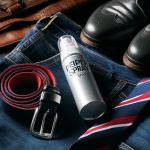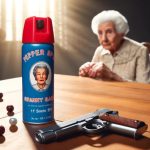Pepper spray, a common self-defense tool, can linger far beyond its initial painful encounter. Remarkably, under certain conditions, its residue can remain active on surfaces for weeks or even months, posing unseen risks and challenges.
This striking fact opens up a myriad of questions about safety, decontamination, and the science behind this persistence. In this article, we dive into the world of pepper spray residue, uncovering how it interacts with different materials and environments.
Our exploration will equip you with essential knowledge and practical advice, ensuring you’re prepared to deal with this invisible hazard.
So, how long does pepper spray stay on surfaces?
Pepper spray can stay on surfaces for varying durations, affected by factors like the type of spray, the surface material, and environmental conditions. The effects of pepper spray are temporary, typically lasting between 30 minutes to an hour. However, the physical discomfort might persist for a few hours, and full recovery might take up to 24 hours, depending on exposure and individual sensitivity.
If pepper spray is used indoors, it’s important to clean it up properly to avoid prolonged exposure4. Here are some steps for cleaning up pepper spray:
- Mask Up: Wear gloves, safety glasses, and something to cover your nose and mouth to avoid breathing in pepper particles or exposing your skin.
- Air Out the Area: Open all windows and entrances to allow maximum ventilation of the area. Fans can be used to assist ventilation.
- Scrub and Vacuum the Area: Use oil-free soap, like dishwashing soap, to clean the pepper spray off any walls, rugs, or furniture. Let the soap sit for 15 minutes. Then, rinse it off with cold water. You should also vacuum any fabric carpet or furniture.
- Block Off the Area: Depending on the environment and level of contamination, restrict access to the area until complete decontamination is observed.
So, let’s get started.
Contents
- 1 Purpose of Pepper Spray
- 2 Understanding How Long Does Pepper Spray Last
- 3 Effects of Pepper Spray
- 4 Active Ingredients in Pepper Spray
- 5 Contact with Pepper Spray
- 6 Contact Lenses and Temporary Blindness
- 7 Mucous Membranes and Residue Damage
- 8 Heat Unit Measurement in Pepper Sprays
- 9 Types of Pepper Sprays and Their Duration
- 10 Factors That Affect the Duration of Pepper Spray’s Effectiveness
- 11 Conclusion
Purpose of Pepper Spray
The primary aim of pepper spray is to serve as a non-lethal method of protection, empowering individuals to defend themselves in threatening situations. Crafted from the fiery essence of chili peppers, this defensive tool harnesses the power of Oleoresin Capsicum (OC) to incapacitate potential aggressors.
| Aspect | Description | Impact |
| Chemical Composition | OC, the active ingredient, is derived from chili peppers. | Causes intense irritation to the eyes, skin, and respiratory system. |
| Immediate Effects | Upon contact, it induces temporary blindness, coughing, and nausea. | Temporarily incapacitates the attacker, providing a window to escape. |
| Application | Directly sprayed into the attacker’s eyes or face from a safe distance. | Maximizes the distance between the defender and the aggressor. |
| Accessibility | Should be carried in accessible spots like belt holsters or outer coat pockets. | Ensures quick and efficient deployment in emergencies. |
| Legal and Safe Use | Intended strictly for self-defense; misuse may lead to legal repercussions. | Encourages responsible ownership and application in dire circumstances only. |
Pepper spray shines as a beacon of self-reliance, allowing folks to navigate through the world with an added layer of security. It’s a testament to the ingenuity of using nature’s own arsenal for our safeguarding.
However, wielding such a potent tool demands a keen sense of responsibility and awareness of the legal landscape surrounding its use.
Understanding How Long Does Pepper Spray Last
Understanding how long pepper spray can linger on surfaces after being deployed is crucial for ensuring safety and proper cleanup. This persistence varies widely, influenced by the spray’s formula, the nature of the contacted surface, and the surrounding environment.
Below is a breakdown of key factors affecting the duration pepper spray can remain active on different surfaces, based on extensive research and analysis:
| Surface Type | Expected Duration | Notes |
| Porous (e.g., carpets, clothes) | Days to weeks | Soaks in, challenging to fully remove without deep cleaning. |
| Non-Porous (e.g., glass, metal) | Hours to days | Easier to wipe off but can spread over a larger area during cleaning. |
| Wood | Days | May seep into cracks, retaining residue; potential for surface damage. |
| Painted Surfaces | Varies | Chemical reaction can lead to discoloration or damage; prompt cleaning is advised. |
| Outdoor (e.g., cement, concrete) | Days to weeks | Textured surfaces trap particles; environmental factors can prolong presence. |
The nature of the surface plays a pivotal role, with porous materials like fabric and carpets absorbing the spray, making it stubborn to eliminate. In contrast, non-porous surfaces such as glass or metal facilitate easier removal, albeit with a risk of spreading the irritant over a wider area if not properly cleaned.
Environmental conditions such as humidity and temperature further influence the pepper spray’s longevity. High humidity can amplify the spray’s effects, whereas lower temperatures might reduce the rate of evaporation, allowing it to remain potent for longer periods.
Prompt and thorough cleaning is essential across all surfaces to mitigate the pepper spray’s impact and prevent prolonged exposure.
Effects of Pepper Spray
Pepper spray, a prevalent self-defense aerosol, contains capsaicin, which is extracted from chili peppers. It’s designed to incapacitate by causing acute irritation to the eyes, skin, and respiratory system.
Immediate Effects on Humans
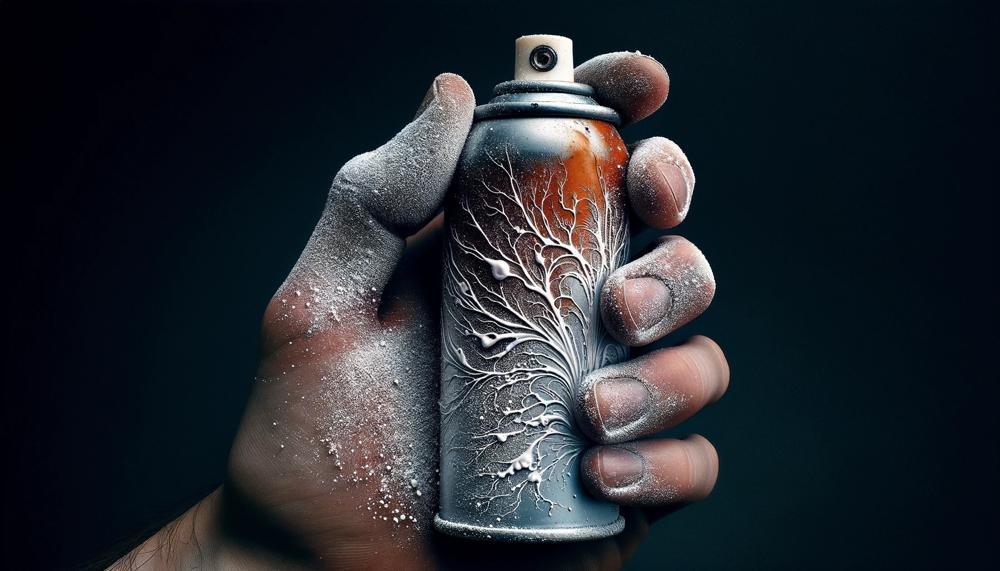
- Eyes: Causes severe irritation and conjunctivitis, leading to temporary blindness due to the swelling of the eyelids.
- Skin: Triggers intense burning sensation, redness, and blisters depending on exposure time.
- Respiratory System: Induces coughing, wheezing, and in extreme cases, respiratory distress especially in asthma sufferers.
Effects on Surrounding Surfaces
Pepper spray residue on surfaces can remain active for days, posing risks via indirect contact:
- Skin Contact: Capsaicin residue can cause burns and blistering upon touch.
- Ingestion Risks: Contaminated objects or foodstuffs can lead to gastrointestinal distress characterized by severe pain and vomiting.
Long-Term Environmental Impact
Apart from immediate toxicity, pepper spray can affect pets and wildlife, causing similar symptoms of distress as in humans.
| Agent | Effect on Humans | Effect on Environment |
| Capsaicin | Eye/skin irritation, respiratory issues | Potential harm to animals; contamination of water sources |
| Propellant | Potential respiratory irritant | Ozone depletion (if CFCs used) |
Precautions and Cleanup
Given the persistence of capsaicin, effective cleanup involves:
- Ventilation: Open windows and use fans to disperse aerosol particles.
- Cleaning Surfaces: Use a solution of baking soda and water to neutralize capsaicin.
Active Ingredients in Pepper Spray
The primary active ingredient in pepper spray is capsaicin, derived from chili peppers, which lends this self-defense tool its fiery sting. Capsaicin targets the eyes and skin, causing intense burning sensations, temporary blindness, and disorientation.
This potent component is responsible for the spray’s effectiveness, making it a popular choice for personal safety and law enforcement purposes.
Impact on Surfaces and Duration
The persistence of pepper spray on surfaces is influenced by several factors, including the formulation’s concentration of capsaicin, environmental conditions, and the type of surface it contacts.
Higher concentrations of oleoresin capsicum (OC), which contains capsaicin, result in longer-lasting residues that can remain potent on surfaces for weeks if not properly cleaned.
Table of Pepper Spray Ingredients and Effects on Surfaces
| Ingredient | Role | Effect on Surfaces |
| Capsaicin | Primary active compound | Creates burning sensation; residue longevity depends on concentration and environmental conditions. |
| Oleoresin Capsicum (OC) | Extract containing capsaicin | Higher OC percentage increases potency and residue duration on surfaces. |
| Propellants | Aid in delivery | Do not significantly affect surface residue duration. |
Decontamination and Precautions
Decontaminating surfaces exposed to pepper spray involves thorough cleaning with solutions that can break down the oily residue left by capsaicin and OC compounds.
Simple household items like soap and water, vinegar, or alcohol-based cleaners can be effective, but repeated cleaning may be necessary to fully remove the irritants.
For folks keen on keeping their homes or possessions free from the long-lasting effects of pepper spray, it’s crucial to act swiftly in cleaning any contaminated surfaces.
Contact with Pepper Spray
Pepper spray, a common self-defense tool, is known for its immediate and intense effects. When sprayed, the main ingredient, capsaicin, targets the eyes and skin, causing a burning sensation and disorientation.
However, aside from its immediate impact, it is crucial to consider how long pepper spray remains active on surfaces after being deployed.
Persistence of Pepper Spray on Surfaces
The duration that pepper spray can linger on surfaces varies significantly based on several factors:
- Type of Surface: Porous materials like cloth may retain capsaicin longer than non-porous surfaces like metal or plastic.
- Environmental Conditions: Humidity, temperature, and air flow can affect the evaporation or degradation of the capsaicin content.
- Concentration of Capsaicin: Higher concentrations may prolong the duration of residue effectiveness.
Cleaning Up Pepper Spray
To mitigate the effects of pepper spray residue, thorough cleaning is essential. Suitable cleaning agents include soap, vinegar, or alcohol-based solutions.
These substances help break down the oily nature of capsaicin, making it easier to remove.
Table of Factors Affecting Pepper Spray Residue Longevity
| Factor | Impact on Longevity | Cleaning Method |
| Porous Surfaces | Longer residue presence | Soap and water, repeated cleaning |
| Environmental Conditions | Variable impact | Adjust cleaning method based on humidity and temperature |
| Capsaicin Concentration | Higher concentration, longer presence | Alcohol-based cleaners for more effective removal |
Contact Lenses and Temporary Blindness
Pepper spray, or OC spray, packs a punch against attackers, but it’s a real menace for those wearing contact lenses. Here’s the lowdown on how this defensive spray can turn into an eye nightmare for lens-wearers.
| Issue | Risk | Outcome |
| Sponge Effect | Increased exposure | Severe symptoms, possible eye damage |
| Trap Trouble | Extra irritation | Difficulty in lens removal, vision problems |
| Infection Invitation | Eye infections | Conjunctivitis, corneal ulcers |
| Rubbing Woes | Further irritation and contamination | Damage to eyes and lenses, spread of OC |
Wearing contact lenses in a pepper spray dust-up? Not cool.
Mucous Membranes and Residue Damage
Pepper spray, a widely recognized self-defense tool, unleashes a fiery tempest on mucous membranes, leading to a fierce and immediate reaction.
This reaction is primarily due to capsaicin, the spicy soul of peppers, which turns the body’s own defenses into a moment of vulnerability.
When this pungent adversary meets the mucous membranes, it ignites a burning sensation, teary eyes, coughing fits, and a struggle to catch one’s breath, encapsulating an encounter that’s as brief as it is intense.
Impact on Mucous Membranes
| Area Affected | Symptoms | Duration of Symptoms |
| Eyes | Intense burning, temporary blindness, excessive tearing | 15-30 minutes |
| Respiratory System | Difficulty breathing, coughing, sensation of choking | 10-30 minutes |
| Skin | Burning sensation, redness | 45-60 minutes |
Healing Time
The road to recovery from this fiery ordeal typically begins soon after exposure, with the severity of symptoms dwindling as minutes tick by. Complete healing from pepper spray’s kiss, however, depends on a few hearty variables:
- Immediate Action: Speedy decontamination can significantly reduce recovery time.
- Sensitivity: Those with a delicate constitution or pre-existing conditions might find the path to feeling right as rain a bit longer.
- Exposure Level: A direct hit or a prolonged tango with pepper spray residue dictates the length of discomfort.
For most, the mucous membranes start to find their way back to normalcy within a couple of hours, feeling right as rain. In the grand tapestry of things, though, it could take up to 24 hours for a complete turnaround, especially for those who wear contact lenses or have heightened sensitivity.
Tips for Quick Healing
- Blink and Rinse: If it’s your eyes that have borne the brunt, blinking rapidly helps. Rinse them with cold water or saline solution to bid the fiery guest goodbye.
- Fresh Air is Fair: For those coughing spells, fresh air is your ally. Find an open space, breathe deeply, and let the wind do its healing dance.
- Avoid Rubbing: This might seem like a nifty trick to ease the burn, but it’s a foe in disguise. Rubbing the affected areas can push the capsaicin deeper, prolonging the agony.
In the vast narrative of self-defense tools, pepper spray holds its ground as a formidable chapter, capable of halting danger in its tracks.
Heat Unit Measurement in Pepper Sprays
Pepper sprays, those formidable allies in personal defence, owe their fiery disposition to capsaicin, the very compound that grants chili peppers their notorious heat. But when it comes to gauging the intensity of pepper sprays, folks often scratch their heads at the abbreviations SHU and OC. Let’s clear the air with a bit of clarity, shall we?
The Tale of Two Measurements: SHU vs. OC
| Aspect | SHU (Scoville Heat Units) | OC (Oleoresin Capsicum) |
| What It Measures | Overall ‘spiciness’ or heat level based on sensory perception. | Specific concentration of capsaicin present in the pepper spray. |
| Origin | Devised by Wilbur Scoville in 1912. | Refers to the oily resin extracted from chili peppers. |
| Use in Pepper Sprays | Indicates the potential heat intensity a user can expect. | Measures the actual capsaicin content, providing a direct indication of effectiveness. |
| Scale | Can range from 0 to over 2 million for the most blistering peppers. | Used to specify the percentage of capsaicin and related capsaicinoids. |
In essence, while SHU gives you an idea of the heat you’re dealing with, OC zeroes in on the potency of the capsaicin cocktail in your pepper spray. Think of SHU as the general ‘oomph’ of the heat and OC as the nitty-gritty of what’s actually going to give the bad guys a hard time.
Most pepper sprays dance in the range of 2 million to a staggering 5.3 million SHU, hotter than the fieriest of chili peppers. Yet, it’s the OC content that dictates how that heat plays out in a defensive scenario.
High SHU ratings scream of a pepper spray’s potential wrath, while a substantial OC percentage assures you of its ability to deliver on that promise, incapacitating an attacker more effectively by targeting their mucous membranes with precision.
Types of Pepper Sprays and Their Duration
Understanding the variety of pepper sprays and their respective duration on surfaces is crucial for informed self-defense choices.
| Type | Characteristics | Surface Duration |
| Stream Sprays | Narrow stream emission | 30-45 minutes |
| Cone Mists | Broad mist coverage | Up to 1 hour |
| Foam Sprays | Foamy substance | 45-60 minutes |
| Gel Sprays | Thick, sticky gel | 45 minutes to over an hour |
| Fogger Sprays | Wide dispersal like fog | 30-60 minutes |
| Law Enforcement Grade | High OC, UV dye | Potentially over an hour |
| Bear Sprays | Formulated for wildlife | Up to several hours |
Each type of pepper spray suits different situations, with varying efficacy and persistence on surfaces.
Factors That Affect the Duration of Pepper Spray’s Effectiveness
| Factor | Description | Impact |
| Capillary Action | The chemical makeup of capsaicin affects how it adheres to surfaces. | More adhesive sprays linger longer. |
| Surface Porosity | Materials like fabric absorb and retain spray differently than smooth surfaces. | More porous surfaces hold spray longer. |
| Environmental Conditions | Wind, humidity, and temperature alter the evaporation rate of the capsaicin oils. | High humidity and low temperature can extend presence. |
| Formulation | Concentration of capsaicin and type of propellant used in the spray. | Higher capsaicin concentrations and oil-based propellants increase duration. |
| Exposure to Elements | Direct sunlight or rain can degrade the capsaicin compound. | Less exposure to elements preserves the spray’s potency. |
| Method of Application | The way pepper spray is applied (stream, mist, gel) affects its adherence. | Gels and foams stick longer than aerosols or streams. |
Pepper spray clings to surfaces with a tenacity that’s influenced by a blend of factors. The essence of capsaicin, the fiery component, dictates its adhesive prowess. Surfaces like fabric grab and clutch the spray more fiercely than sleek, non-porous ones, allowing the fiery residue to linger.
The caress of the environment, with its dance of wind, warmth, and moisture, plays with the capsaicin’s longevity, often holding it in place longer under cooler, damper conditions.
The concoction’s strength, spiked with varying levels of capsaicin and different propellant types, can make the pepper spray more tenacious, with oil-based formulas hugging surfaces longer.
Conclusion
Pepper spray is a good way to protect yourself, but it can have effects that last for a long time after you use it. To clean up effectively and limit dangerous contact, it is important to know how long pepper spray dust lasts on different surfaces. How long it stays active depends a lot on the type of surface and the factors of the surroundings. Fabric and other porous materials can hold on to leftovers for weeks, making them harder to clean. Non-porous surfaces, like metal or glass, are easier to clean, but they can still get dirty because of the dust that your cleaners leave behind.
By slowing down the rate at which the capsaicin oils evaporate, high humidity and low temperatures can make pepper spray last longer on any surface. There are many effective ways to clean, from using soap and water to get rid of light leftovers to using special cleansing products for tougher buildups. It is crucial to take safety precautions during cleanup to prevent re-exposure to allergens.
If you are a police officer, a worried neighbor, or someone who might use pepper spray, these facts will help you deal with its effects in a safe and responsible way. Ensure prompt and thorough cleaning to mitigate risks, maintain the safety of areas, and reduce the likelihood of unintentional exposure to leftovers that may remain active for extended periods after initial use.
